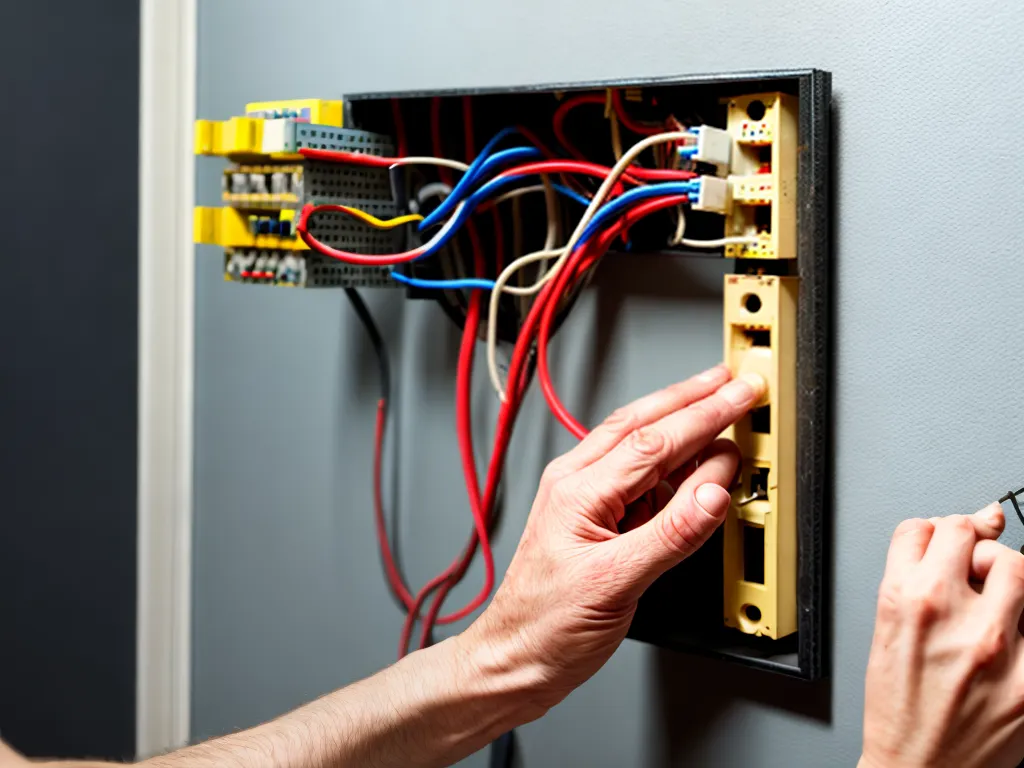
How to Safely Replace Knob-and-Tube Wiring in Your Home
Overview of Knob-and-Tube Wiring
Knob-and-tube wiring was commonly installed in homes built before the 1940s. It features:
- Wires that are run through open spaces in walls and ceilings
- Ceramic knobs that hold the wires in place
- Tubes that protect wires where they pass through framing
- No ground wire (which modern wiring requires for safety)
While knob-and-tube wiring was safe when installed properly, it can become hazardous as it ages. Insulation and safety standards have also changed over the decades. For these reasons, I recommend replacing knob-and-tube wiring in older homes.
Dangers of Knob-and-Tube Wiring
There are several risks associated with old knob-and-tube electrical systems:
- Fire hazard: The insulation on old wiring can crack or decay over time, exposing the conductors. This can lead to short circuits and sparks.
- Shocks and electrocution: Without a ground wire, knob-and-tube systems pose a serious shock risk. Any fault in the system can energize metal parts of the house.
- Insufficient power: Knob-and-tube wiring was not designed to handle the power demands of modern appliances and electronics. Outlets may only be rated for 15 or 20 amps.
- Difficulty with insurance: Many insurance companies won't issue policies for homes with knob-and-tube wiring due to the risks.
For these reasons, upgrading the wiring makes your home much safer.
Hiring an Electrician
I strongly recommend hiring a licensed electrician to replace knob-and-tube wiring. Electrical work carries serious risks, including fire and electrocution. Attempting DIY electrical work without proper training puts your safety at risk.
When hiring an electrician:
- Verify their license: Ask to see their state electrical license and ensure it is current.
- Check reviews: Look for reviews on sites like Google or Yelp to evaluate their reputation.
- Get multiple quotes: Get quotes from at least 3 electricians to compare pricing.
- Ask about their experience: Choose an electrician who has significant experience with old wiring replacements.
Replacing knob-and-tube wiring is expensive -- often between $8,000-$15,000 for a full rewire of a single family home. Get quotes from several electricians before committing.
Overview of the Rewiring Process
Replacing the knob-and-tube wiring in a house is a major undertaking. Here is an overview of the typical process:
Inspection and Planning
- The electrician will inspect your existing wiring to see how accessible it is. Planning often involves some destructive investigation to look inside walls.
- They will plan the optimal routes for the new wiring. Important factors include where your electrical panel is located and access between floors.
- You'll agree on a plan of action for the rewiring work.
Running New Wires
- The electrician will fish the new copper wiring through your walls, ceilings, and floors. This often requires cutting holes to feed wires through and patching afterwards.
- For trickier routes, electricians may need to cut larger access holes through drywall that are patched up after.
- All accessible knob-and-tube wiring will be removed. Inaccessible, unused wiring may be left in place.
Installing New Outlets, Switches and Fixtures
- The electrician will remove old outlets, switches and wiring fixtures and replace them with modern equipment.
- Light fixtures, fans, appliances and other items may need to be temporarily removed to access wires.
- GFCI outlets will be installed in kitchens, bathrooms and other locations to prevent shocks.
Connecting to the Panel
- The new wires will be properly terminated and connected to your home's breaker panel.
- If needed, the panel will also be upgraded to a sufficiently large amperage capacity.
Safety Precautions During the Rewiring Process
Your family's safety should be the top priority during a rewiring project:
- Turn off circuits - Electrical work can't be performed live. The power must be shut off at the breaker panel.
- Mind exposed wires - Avoid contact with any exposed conductors. Assume they are live.
- Prevent fire risks - Don't allow rubbish to accumulate. Have functioning smoke detectors.
- Limit access to work areas - Keep children and pets away from unsafe areas.
- Check credentials - Ensure the electricians are fully licensed and insured.
- Follow safe practices - The pros should adhere to necessary precautions at all times.
Staying vigilant will help ensure the knob-and-tube removal process is smooth and hazard-free.
Finishing Touches After the Rewiring is Complete
Once the new electrical system is installed and functional, a few finishing touches will help get your home back in shape:
- Patch and repair walls, floors or ceilings where holes were made to run wires. Paint patches to match existing colors.
- Reinstall any furniture, fixtures, outlets or appliances that were removed during the process.
- Add rocker-style light switches to match modern decor.
- Label the new circuits clearly in the breaker panel.
- Hire contractors to repaint or restore any damaged decor.
- Replace smoke detectors, carbon monoxide detectors and add ground fault circuit interrupters (GFCIs).
- Consider adding surge protectors, lighting fixtures and wiring upgrades while walls are open.
The rewiring process is invasive, so take time afterwards to ensure your home is restored to its original state. With all new wiring in place, you'll gain safety, added functionality and peace of mind.